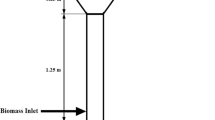Abstract
The results of experimental and computational studies of torrefaction (low-temperature pyrolysis) of granular plant biomass are presented. As a result of this process, high-quality solid hydrophobic biofuel with increased calorific value is obtained from biomass of various types (including waste). Unlike fossil coal, torrefied fuel contains virtually no sulfur and heavy metals, has a lower ash content, and is a carbon-neutral product. The carbon dioxide released during the combustion of plant biofuels is completely absorbed during the period of plant growth. Biofuels are a renewable resource. The annual increase in biomass is 400 billion t, and the rate of energy accumulation by terrestrial biomass is 3 × 1021 J/year. The article considers a vertical reactor with a dense layer of pellets moving towards the heating gas flow under the action of its own weight and features of its operation, taking into account the possible implementation of the concept of a controlled exothermic reaction. To ensure the set mode, the plant has two control units: for controlling and maintaining the set temperature of the coolant at the reactor inlet and for controlling the opening of dampers for unloading finished products into the cooling zone. Experimental and calculated data are presented for three characteristic operating modes of the installation: with limitation of the exothermic reaction due to the control of the inlet temperature, with a controlled exothermic reaction, and with the production of biochar. The second mode turned out to be the most energy efficient. The deviation of the calculated data from the experimental data was no more than 4%. It is shown that the use of the energy of an exothermic reaction can significantly increase the energy efficiency of the process of obtaining carbon-neutral solid biofuel.







Similar content being viewed by others
REFERENCES
Non-Traditional Energy. http://gigavat.com/netradicionnaya_energetika_biomassa_3.php
P. Basu, Biomass Gasification and Pyrolysis. Practical Design and Theory (Elsevier, Kidlington, 2010).
F. F. Felfli, C. A. Luengo, J. A. Suarez, and P. A. Beatón, “Wood briquette torrefaction,” Energy Sustainable Dev. 9, 19–22 (2005). https://doi.org/10.1016/S0973-0826(08)60519-0
M. Pach, R. Zanzi, and E. Bjornbom, “Torrefied biomass a substitute for wood and charcoal,” in Proc. 6th Asia-Pac. Int. Symp. on Combustion and Energy Utilization, Kuala Lumpur, Malaysia, 2002.
M. J. Prins, K. J. Ptasinski, and F. J. J. G. Janssen, “More efficient biomass gasification via torrefaction,” Energy 31, 3458–3470 (2006). https://doi.org/10.1016/j.energy.2006.03.008
A. Demirbas, “Biorefineries: Current activities and future developments,” Energy Convers. Manage. 50, 2782–2801 (2009). https://doi.org/10.1016/j.enconman.2009.06.035
M. J. C. van der Stelt, H. Gerhauser, J. H. A. Kiel, and K. J. Ptasinski, “Biomass upgrading by torrefaction for the production of biofuels: A review,” Biomass Bioenergy 35, 3748–3762 (2011). https://doi.org/10.1016/j.biombioe.2011.06.023
K.-Q. Tran, X. Luo, G. Seisenbaeva, and R. Jirjis, “Stump torrefaction for bioenergy application,” Appl. Energy 112, 539–546 (2013). https://doi.org/10.1016/j.apenergy.2012.12.053
M. Simonic, D. Goricanec, and D. Urbancl, “Impact of torrefaction on biomass properties depending on temperature and operation time,” Sci. Total Environ. 740, 140086 (2020). https://doi.org/10.1016/j.scitotenv.2020.140086
V. M. Zaichenko, O. M. Larina, A. V. Markov, and A. V. Morozov, “Device for thermal conversion of biomass,” RF Patent No. 175131 (U1), MPK C10J 3/00, Byull. Izobret., No. 33 (2017).
V. N. Kozlov, Modern State of Coal Combustion Theory (Metallurgizdat, Moscow, 1939) [in Russian].
A. N. Kislitsyn, Wood Pyrolysis: Chemistry, Kinetics, Products, New Processes (Lesn. Prom-st., Moscow, 1990) [in Russian].
V. M. Zaichenko, V. F. Kosov, Yu. S. Kuz’mina, and G. A. Sychev, “Plant for torrefaction of granular biomass,” RF Patent No. 161775 (U1), MPK C10J 3/00, Byull. Izobret., No. 13 (2016).
A. L. Shevchenko, G. A. Sytchev, and V. M. Zaichenko, “The transition to energy efficient biomass torrefaction technology,” in Proc. Int. Conf. on Automatics and Energy (ICAE 2021), Vladivostok, Russia, Oct. 7–8, 2021; J. Phys.: Conf. Ser. 2096, 012082 (2021). https://doi.org/10.1088/1742-6596/2096/1/012082
A. L. Shevchenko and L. B. Direktor, “The program for calculating the thermophysical parameters of the biomass thermal conversion reactor (PYRBM),” RF Software Registration Certificate No. 2018664704 (2018).
A. L. Shevchenko, G. A. Sytchev, and V. M. Zaichenko, “Energy efficient technology for torrefied biofuel production,” in Proc. 2020 Int. Multi-Conf. on Industrial Engineering and Modern Technologies (FarEastCon), Vladivostok, Russia, Oct. 6–9, 2020 (IEEE, Piscataway, N.J., 2020), p. 9271198. https://doi.org/10.1109/FarEastCon50210.2020.9271198
S. E. Perederii, “Will torrefied pellets be produced in Russia?,” LesPromInform, No. 1 (147), 122–125 (2020).
Funding
This work was financially supported by the Ministry of Science and Higher Education of the Russian Federation (State Assignment no. 075-01056-22-00 dated December 24, 2021).
Author information
Authors and Affiliations
Corresponding author
Rights and permissions
About this article
Cite this article
Zaichenko, V.M., Sychev, G.A. & Shevchenko, A.L. Thermal Effects of Plant Origin Biomass Torrefaction: Experiment and Mathematical Modeling. Therm. Eng. 70, 346–353 (2023). https://doi.org/10.1134/S0040601523050087
Received:
Revised:
Accepted:
Published:
Issue Date:
DOI: https://doi.org/10.1134/S0040601523050087




